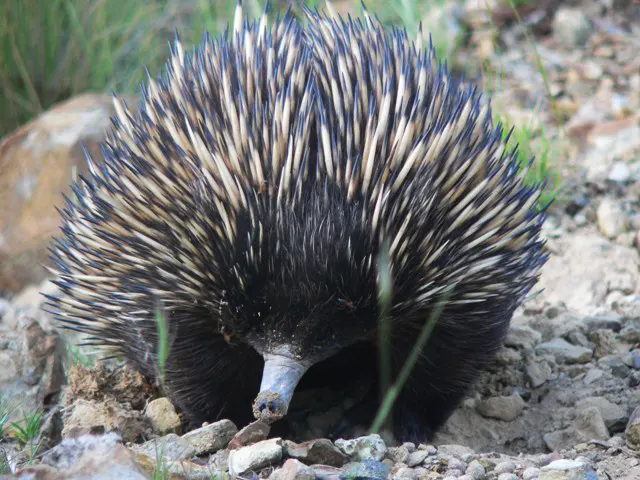
During Spring echidnas are much more visible than usual and often encountered in unusual locations. Echidnas travel long distances looking for food, and may travel through your property or yard. Many calls received by WIRES are regarding echidnas that have 'dug' themselves in, and do not seem to want to move on. If you approach an echidna it defends itself the only way it can, by digging into the ground and this happens whenever it feels insecure or in danger. It may also roll itself into a ball or cling on to any surface it can.
What you should do if you see an echidna
If you see an echidna and it is NOT injured please leave it alone and DO NOT approach it and do not attempt to contain it. In most circumstances you do not need to call WIRES. We try to never relocate any healthy echidna as it risks them losing their scent trail or leaving young unattended in the burrow. Echidnas have a type of inbuilt GPS which we don’t want to interrupt.
The best thing to do in this situation is for everyone to simply to leave the area for a period of time, allowing the echidna to make its own way. If you have a pet please keep it contained well away from the animal, and you will find that the echidna will move away as soon as it is sure it is out of danger, and feels secure.
Male echidna are often around during spring following scent trails of females and they need to be left alone wherever possible as this is normal behaviour. If you do see an echidna crossing a road or in a busy area the best course of action is NOT to approach it - if you do they will curl up and burrow in or cling on and then they may not move for some time (placing it in even more danger).
You CAN HELP if it safe to do so by stopping the traffic and allowing the echidna to make its own way off the road.
Never try to relocate any echidna
Female echidnas can have young in burrows that they leave alone while they go out to forage for food and it is critical that they are able to return. If they are ‘rescued’ or contained by well-meaning people while they are away from their young it can leave a young puggle to starve to death in the burrow.Please NEVER EVER use a shovel to try and lift any echidna as it most often results in broken toes and spines.
What to do if your vehicle collides with an echidna
Any echidna injured by cars MUST be taken to a veterinary clinic and X-rayed. It is impossible to examine these animals properly without X-ray as you cannot feel broken bones as in other animals. Please call WIRES immediately 1300 094 737 for further advice and assistance and please take note of the exact location of the collision.
Echidnas cannot tolerate temperatures above 30 degrees. Please try to ensure if transporting an echidna that the temperature is below 30 degrees.
Please also check the surrounding area for young as very young echidnas can easily be dislodged from the flap like pouch of the mother on impact with a vehicle.
If you find a very young puggle alone and unattended by an adult echidna
If you should find a young echidna with no spines or very few, please call WIRES immediately 1300 094 737 and ensure it is kept cool until help has arrived, an ice brick in hot weather should be placed close by the puggle in order to keep it cool. You can place the puggle in a jumper and an ice brick close by, DO NOT put the puggle directly on the ice brick.
Temperatures above 30 degrees are fatal for this species.
To access 24/7 rescue advice and assistance for sick, injured and orphaned native animals call 1300 094 737, or fill in the online rescue form.
Sign Up for Wildlife News
Stay in touch and get our regular rescue stories, WIRES updates and a free copy of our 15 Ways to Help Wildlife ebook
